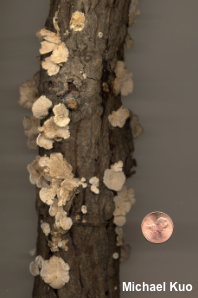| Major Groups > Gilled Mushrooms > Pale-Spored > Pleurotoid Mushrooms > Schizophyllum commune |

|
Schizophyllum commune [ Basidiomycetes > Agaricales > Schizophyllaceae > Schizophyllum ... ] by Michael Kuo When I was a kid, a friend of mine lived in a commune across town. I used to love his stories; it sounded as though everyone who lived there was schizophrenic. But by the time we reached middle school, my friend and his family had moved out of the Schizophyllum commune, choosing the decidedly more mainstream living arrangement known to realtors as the "single-family home." Ah, the domestication of a generation . . . now there is even a Gap outlet at Haight & Ashbury! The species name "commune" actually does refer to shared ownership, in an odd way; Schizophyllum commune is one of the most widely distributed and common mushrooms on the planet. Not only is it found from sea to shining sea on our continent, it is found on all six of the others. Schizophyllum commune is easily recognized. Its small pleurotoid fruiting bodies lack stems, and they attach themselves like tiny bracket fungi on the deadwood of deciduous trees. Unlike a bracket fungus, however, Schizophyllum commune has what appear to be gills on its underside, rather than pores or a simple, flat surface. On close inspection the "gills" turn out to be merely folds in the undersurface—and they are very distinctively "split" or "doubled" (enlarge the illustrations). Description: Ecology: Saprobic on deadwood or occasionally parasitic on living wood; growing alone or, more frequently, gregariously to clustered; on decaying hardwood sticks and logs (even on planks and boards); year-round (it survives by shriveling up and waiting for more moisture); originally described and named from Sweden; widely distributed in North America and throughout the world. The illustrated and described collections are from Illinois, Indiana, and Kentucky. Cap: 1–4 cm across; fan-shaped when attached to the side of the log; irregular to shell-shaped when attached above or below; finely hairy to velvety or almost granular; dry; whitish to grayish or brownish; sometimes developing concentric textural zones. Gills: Distant; folded together and appearing split down the middle; whitish to grayish. Stem: Absent. Flesh: Tough; whitish; not changing when sliced. Odor: Not distinctive. Spore Print: White. Microscopic Features: Spores 4–6.5 x 1.5–2 µm; subcylindric or subellipsoid; smooth; hyaline in KOH; inamyloid. Hymenial cystidia not found. Pileipellis a cutis of elements 2.5–5 µm wide, sometimes aggregated into upright bundles. Clamp connections present. REFERENCES: Fries, 1821. (Phillips, 1981; Smith, Smith & Weber, 1981; Arora, 1986; Breitenbach & Kränzlin, 1991; Phillips, 1991/2005; Schalkwijk-Barendsen, 1991; Lincoff, 1992; Metzler & Metzler, 1992; Horn, Kay & Abel, 1993; Barron, 1999; Hemmes & Desjardin, 2002; McNeil, 2006; Miller & Miller, 2006; Bougher, 2009; Kuo & Methven, 2010; Ohm et al., 2010; Buczacki et al., 2012; Kuo & Methven, 2014; Desjardin, Wood & Stevens, 2015; Siegel & Schwarz, 2016; Woehrel & Light, 2017; Baroni, 2017; Gminder & Böhning, 2017; Elliott & Stephenson, 2018; Knudsen, 2018; Sturgeon, 2018; Læssøe & Petersen, 2019; McKnight et al., 2021.) Herb. Kuo 06120303, 07010305, 07140311, 08190601, 04270703. This site contains no information about the edibility or toxicity of mushrooms. |
© MushroomExpert.Com |
|
Cite this page as: Kuo, M. (2021, April). Schizophyllum commune. Retrieved from the MushroomExpert.Com Web site: http://www.mushroomexpert.com/schizophyllum_commune.html |



